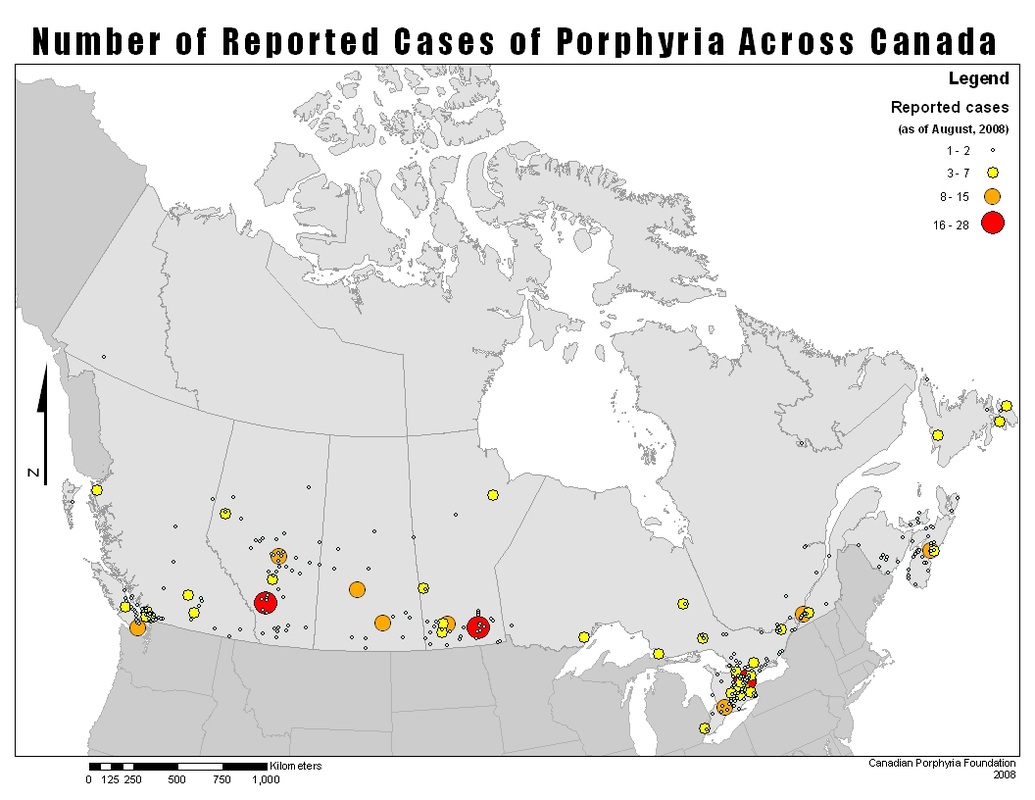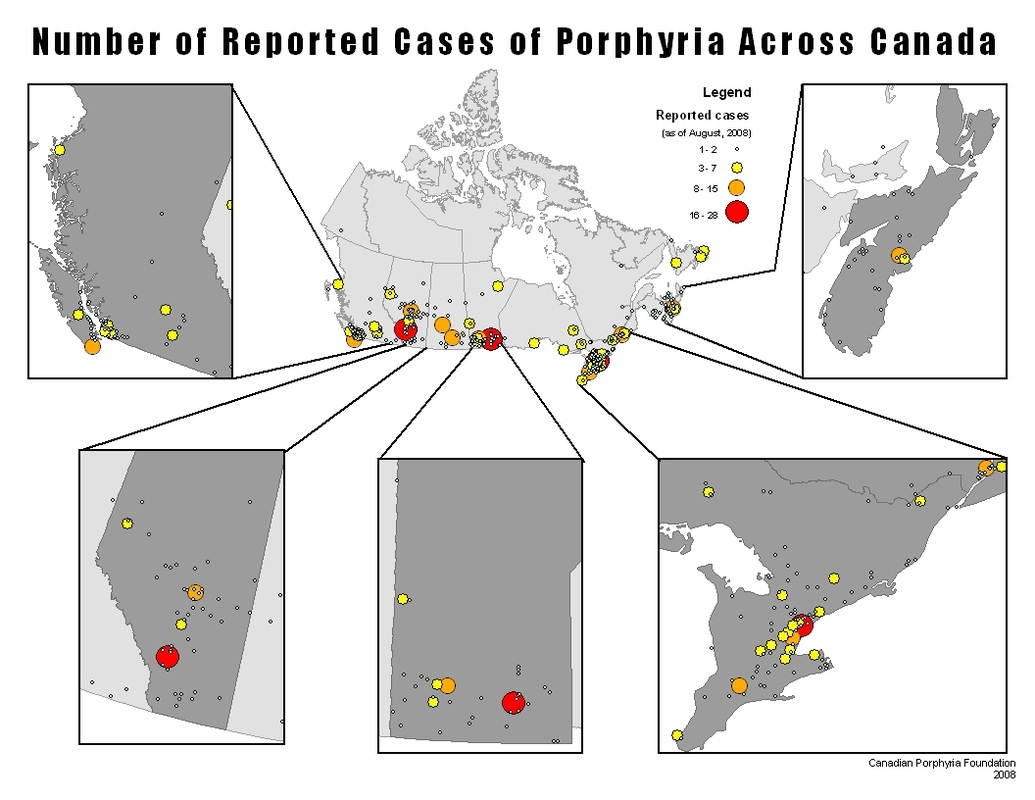Canadian Association for Porphyria 2008
This information was compiled by the Canadian Association for Porphyria in 2008 based on Canadians with porphyria who had contacted them.
Clin Biochem. 1997 Dec;30(8):607-12.
Detection of a R173W mutation in the porphobilinogen deaminase gene in the Nova Scotian "foreign Protestant" population with acute intermittent porphyria: a founder effect.
Greene-Davis ST1, Neumann PE, Mann OE, Moss MA, Schreiber WE, Welch JP, Langley GR, Sangalang VE, Dempsey GI, Nassar BA.
Author information
AbstractOBJECTIVES:Acute intermittent porphyria (AIP) is caused by mutations in the porphobilinogen deaminase (PBGD) gene that disrupt the function of the enzyme. Many mutations that lead to decreased PBGD activity have been described. An Arg to Trp substitution at codon 173 (CGG-->TGG in exon 10) and designated R173W, which leads to a CRIM-negative phenotype, has been reported in Swedish, Finnish, Scottish, and South African kindreds, and in a Nova Scotian proband with fatal AIP. In this work, we investigated the presence of this mutation in a Nova Scotian patient population presenting with AIP.
DESIGN AND METHODS:Single-strand conformation polymorphism analysis and DNA sequencing by TA cloning and Sanger's dideoxy chain termination method, were used to confirm the maternal transmission of this mutation to the proband. The mutation also eliminates an Ncil (also Mspl) endonuclease restriction site, which allows for detection of the mutant allele by polymerase chain reaction amplification and restriction enzyme digestion.
RESULTS:The family of the Nova Scotian proband and four other AIP kindreds showed the presence of the same mutation. These five families are descendants of German, Swiss, and French immigrants historically known as the "Foreign Protestants," who were recruited to Nova Scotia in the 1750s.
CONCLUSION:In all these families, descent from one couple that settled in Nova Scotia in 1751 has been identified by genealogy research, consistent with a founder effect within this population. This is the first identified mutation in PBGD causing AIP that has been linked to a founder effect in descendants of an immigrant population to North America, and which could be traced to such a distant background, similar to the South African variegate porphyria mutation.
PMID: 9455613 [PubMed - indexed for MEDLINE]
Detection of a R173W mutation in the porphobilinogen deaminase gene in the Nova Scotian "foreign Protestant" population with acute intermittent porphyria: a founder effect.
Greene-Davis ST1, Neumann PE, Mann OE, Moss MA, Schreiber WE, Welch JP, Langley GR, Sangalang VE, Dempsey GI, Nassar BA.
Author information
AbstractOBJECTIVES:Acute intermittent porphyria (AIP) is caused by mutations in the porphobilinogen deaminase (PBGD) gene that disrupt the function of the enzyme. Many mutations that lead to decreased PBGD activity have been described. An Arg to Trp substitution at codon 173 (CGG-->TGG in exon 10) and designated R173W, which leads to a CRIM-negative phenotype, has been reported in Swedish, Finnish, Scottish, and South African kindreds, and in a Nova Scotian proband with fatal AIP. In this work, we investigated the presence of this mutation in a Nova Scotian patient population presenting with AIP.
DESIGN AND METHODS:Single-strand conformation polymorphism analysis and DNA sequencing by TA cloning and Sanger's dideoxy chain termination method, were used to confirm the maternal transmission of this mutation to the proband. The mutation also eliminates an Ncil (also Mspl) endonuclease restriction site, which allows for detection of the mutant allele by polymerase chain reaction amplification and restriction enzyme digestion.
RESULTS:The family of the Nova Scotian proband and four other AIP kindreds showed the presence of the same mutation. These five families are descendants of German, Swiss, and French immigrants historically known as the "Foreign Protestants," who were recruited to Nova Scotia in the 1750s.
CONCLUSION:In all these families, descent from one couple that settled in Nova Scotia in 1751 has been identified by genealogy research, consistent with a founder effect within this population. This is the first identified mutation in PBGD causing AIP that has been linked to a founder effect in descendants of an immigrant population to North America, and which could be traced to such a distant background, similar to the South African variegate porphyria mutation.
PMID: 9455613 [PubMed - indexed for MEDLINE]


